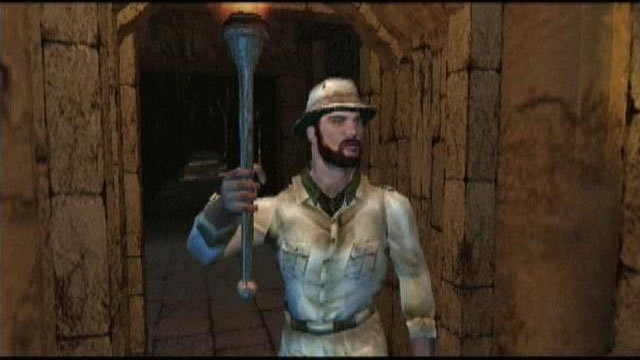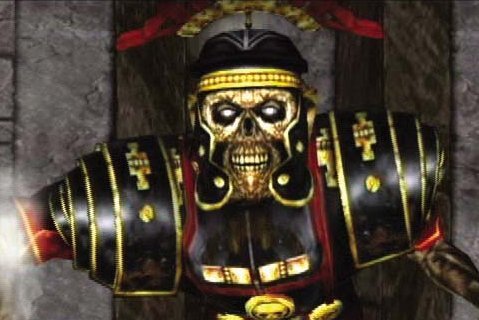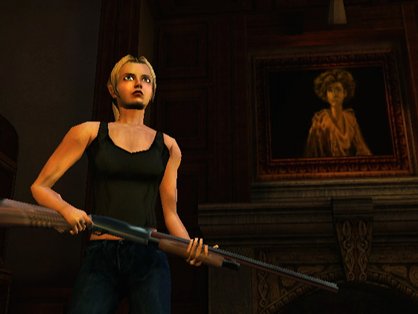
|
Nintendo fans loved the GameCube. Yes, the wait between brilliant games was frequently long and Nintendo was in no rush to cater to the quickly maturing population of core gamers, but folks who gave the lunch box console a chance were rewarded with a slew of brilliant titles. Despite the reputation of being too “kiddie”, GameCube actually did have a fair amount of more mature content; Capcom in particular showed older audiences some love by making the system the main focus for the Resident Evil franchise. However, one of the best M-rated adventures on GameCube came from the last source anybody expected: Nintendo itself.
And yes, there are spoilers ahead!
The ESRB has been rating games for content since 1994, and despite the being one of the industry’s most prolific publishers, Nintendo took eight years to finally publish a game with a mature rating. In 2002, Nintendo finally crossed into “maturity” with the release of Eternal Darkness: Sanity’s Requiem, a survival horror title from Canadian developers Silicon Knights. Critically, the game was a hit, garnering frequent praise for its many, major innovations in the genre. On the commercial side of things, the game fell flat once it hit stores, quite possibly because so many “mature” gamers had jumped ship to PlayStation 2 and Xbox. Regardless of why it failed, plenty of gamers who had stuck with Nintendo picked up the game and turned Eternal Darkness into one of the cult classics of the previous generation.

The survival horror genre caught the attention of the general public with the 1996 release of Resident Evil on PlayStation. That game effectively defined the genre for years, with few games showing a willingness to move away from game’s awkward controls, cheap thrills, and hilariously bad dialogue and acting. Some games showed some imagination; Silent Hill was the first in the genre to focus on establishing a legitimately creepy atmosphere and move the story in a deeper, psychological direction. However, no matter how hard developers tried, the 32/64 bit generation simply lacked the processing power to truly create frightening sights and sounds. The next generation of consoles finally opened the door for titles to emphasize the “horror” in survival horror.
2001 saw the release of Silent Hill 2 on PlayStation 2 and the GameCube remake of Resident Evil hit store shelves in March 2001. Both of these games succeeded in finally realizing truly frightening environments in a video game and even took significant steps in reducing the overall cheesiness that has haunted the acting and writing within the genre. However, these games did next to nothing to fix the awkward controls, camera, and combat that had plagued every entry in the genre since Resident Evil first reared its zombified head six years earlier. Eternal Darkness, on the other hand, wound up being the first game in the genre to effectively marry the technological advantages of the newer hardware with enjoyable gameplay mechanics.
Eternal Darkness actually began life as a Nintendo 64 game, but as development of the title dragged on and the promise of new hardware appeared on the horizon, development was shifted to GameCube. Silicon Knights’ previous title, Blood Omen: Legacy of Kain, had similarly focused on telling a deep, mature story with heavy attention paid to character development. However, Eternal Darkness promised to be a bigger project, with the new hardware allowing for creation of a more realistic, horrifying world and the developer realizing an ambition to use psychology in a game more unique than ever before.
Eternal Darkness’s story is obviously influenced by the works of H.P. Lovecraft, an early 20th century horror author with a penchant for dreaming up terrible creatures whose mere existence caused greater harm to victims’ psyches than physical violence would against victims’ bodies. Eternal Darkness focuses on a struggle between three such malevolent beings; each is an “Ancient,” a giant, powerful, otherworldly creature destined to struggle with the others for dominance. This struggle is presented to the player through the experiences of a variety of characters from various times throughout history, and various places around the world. At the center of the story is Alexandra Roivas, a young woman searching her recently deceased grandfather’s mansion for clues to the truth behind his brutal murder. Early in the game, Alexandra discovers a secret room containing the Tome of Eternal Darkness, an ancient book made from human flesh. Inside the book she reads of Pious Agustus, a Roman Centurion who stumbled upon a Middle East temple containing reanimated corpses and a room with three artifacts, each representing one of the Ancients. Pious chooses one of these artifacts and is then granted a great power, but at the cost of his humanity and being bound to serve one of the Ancients.

The player swaps between controlling Alexandra and whoever she is reading about, including Pious, which allows the player to choose which Ancient the Centurion will serve. Alexandra searches the house, discovering more stories of otherwise normal people who found themselves thrown into the secret war being waged by Pious to return his Ancient to power. What makes these stories particularly interesting are the characters involved and the settings surrounding them. Alexandra gets to experience the lives of some of her ancestors, learning how her family, and grandfather in particular, came to be involved in this mess.
Hidden pages from the book also reveal the lives of many other characters, including a 15th century architect forced to contruct a pillar of flesh for a Middle East warlord, a 9th century messenger who gets unwittingly involved in the assassination of Charlemagne, a World War I reporter who investigates the strange occurrences at an old French cathedral-turned-hospital for the war, a firefighter battling the oil fires in Kuwait during the first Gulf War who stumbles upon the temple constructed by the architect, and many more. Even though most of the characters meet untimely ends due to unfortunate circumstances, it is interesting to control them as they react to these horrific situations and ultimately make some contribution to Alexandra’s final battle to prevent Pious and the Ancient’s conquest.
As macabre and interesting the story and characters are, the gameplay and presentation contribute just as much. While other survival horror games of the time suffered from poor writing and voice work, Eternal Darkness excelled, thanks in large part to a cast of talented actors and the tender love and care Silicon Knights gave developing the game’s world and inhabitants. As for the gameplay, it immediately excelled beyond Resident Evil’s cumbersome, tank-like controls by embracing the more traditional control scheme found in most third person games.
The game’s combat was also a significant improvement thanks to the inclusion of a targeting system that allowed players to strike specific parts of their foes, including the ability to cut off limbs: watching a room full of armless zombies meander about as they fruitlessly try to assault the character is one of the game’s guilty pleasures. Combat was further enhanced by the variation that resulted from the numerous characters and time periods; a dagger-equipped Cambodian slave girl from the 12th century offers an expereince that is quite different than a 20th century firefighter who takes a grenade launcher-equipped assault rifle from the body of a fallen soldier.
Complementing the exploration and combat is the Magick, a rune-based system built on the elements represented by the different Ancients. Runes could be combined in sets of three, five, and seven, and every combination presented a new spell with various offensive, defensive, and regenerative effects that varied based upon the element. All of these elements helped make the game fun to play, but the Sanity Meter is really what made Eternal Darkness stand out.

Each character had different traits that attributed to the varying health and magick meters they possessed, but each character also possessed differing levels of mental stability. Characters who were more likely to have dealt with terrible events before had more sanity than those who were first experiencing terror of this magnitude, but everybody’s meters would drain as the terrible beasts serving the ancients continued their unrelenting assault. As the meter dropped, the world would slowly change, the camera would tilt, and muffled screams and crying would start to emerge in the background noise. Hallucinations might then start: the walls would bleed and characters might see enemies that weren’t actually there. Once the sanity meter reached critical levels, really weird stuff would happen. The character might walk into a room and suddenly fall apart, piece by piece, only to have the screen suddenly flash and reveal the character to still be on the other side of the door way.
However, the best effects were ones that broke the fourth wall; a volume level display might all of a sudden show up and mute the game, the TV could appear to turn off and then on suddenly, the system might appear to reset and return to the GameCube home screen before returning to gameplay, or the player could go to save the game and receive a message saying the data has been corrupted. These Insanity Effects started out as mildly unsettling, became disturbing, and then ultimately freaked out gamers with something worse than gruesome death, loss of progress in the game and broken TVs!
Oh, and be sure to examine the bathtub on the second floor of the mansion!
Between the outstanding story, strong gameplay, and unsettling/innovative insanity effects, it is hard to understand why Eternal Darkness was overlooked by so many gamers upon its release. Nintendo might not have been that popular among the M-rated crowd, but history has shown that one solid game can transform a console’s popularity– just look at what Halo did for Xbox and Wii Sports for Wii. Regardless of Eternal Darkness’s initial lack of popularity among the mainstream, enough people picked up the game and spread the good word about it to make it a cult hit and a revered entry within the survival horror genre; if all the people who loved the game now had picked it up when it first came out, this article probably wouldn’t exist.
Thankfully, there still might be some hope for Eternal Darkness to be revived. First and foremost, the game’s true ending (unlocked after finishing the game three times with Pious choosing each artifact) definitely shows that there is room for a sequel. Second, Silicon Knights has said it would be interested in revisiting its brilliantly crafted universe. Finally, Nintendo still retains the rights to Eternal Darkness and even remains investors in Silicon Knights. However, that last item is what will make or break the future of this brilliant game, because the ball is definitely in Nintendo’s court and the company will have to be the ones to get things moving. Considering the recent history of Kid Icarus, Nintendo has definitely shown that it listens to rabid fans’ demands from time to time, but it is also never in a hurry to revive old franchises. Hopefully Eternal Darkness fans won’t have to wait as long as Kid Icarus fans.




 ShareThis
ShareThis







